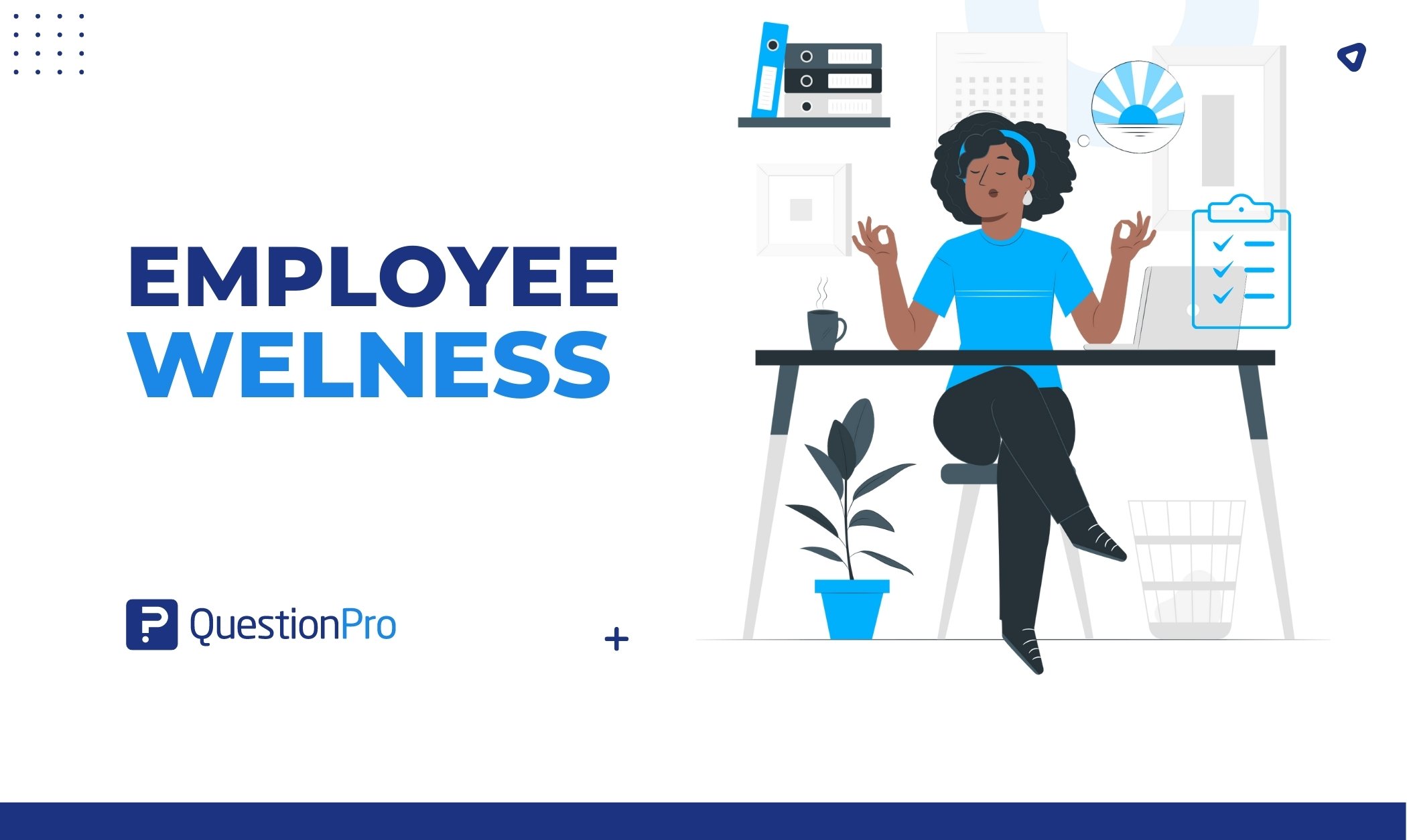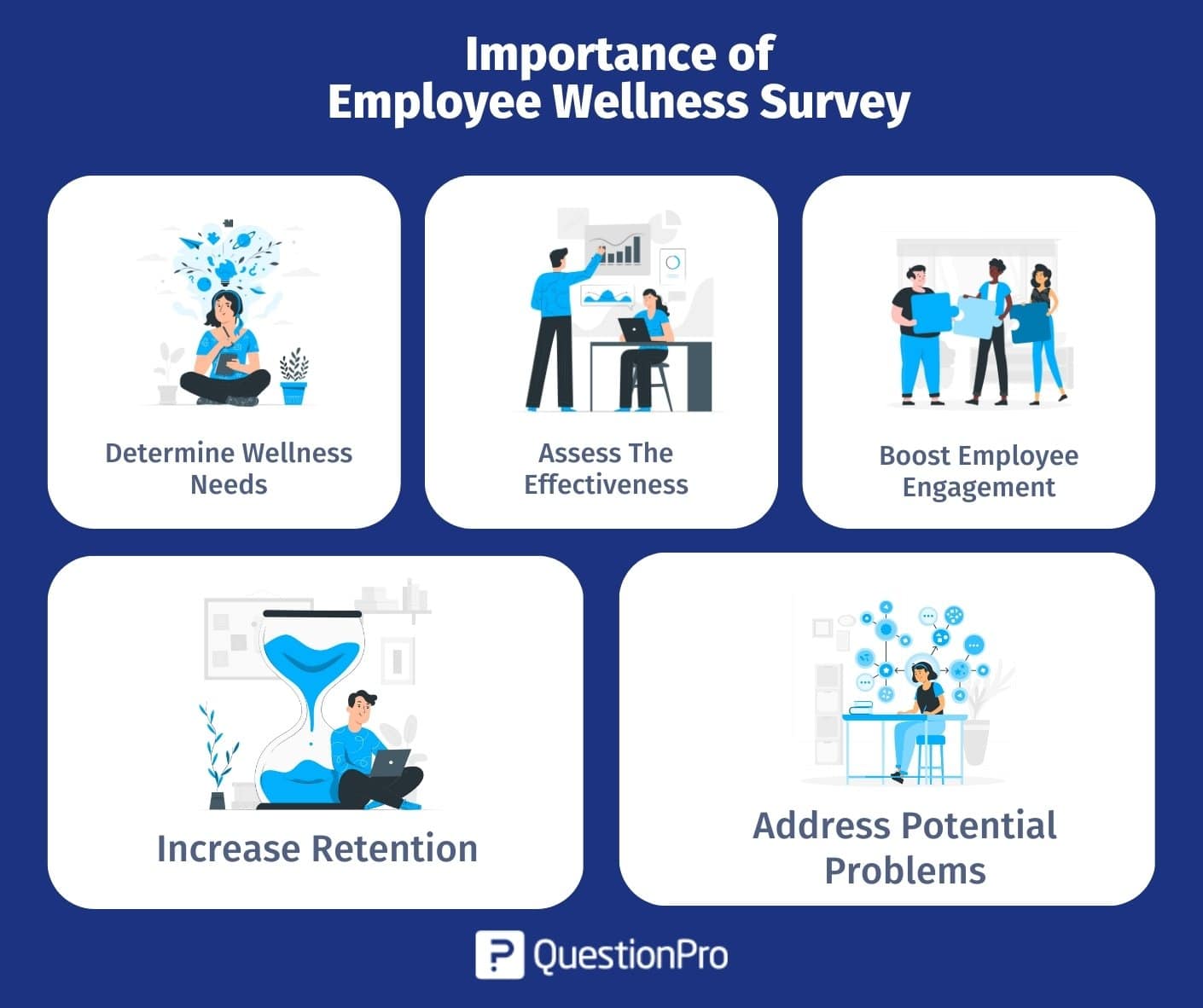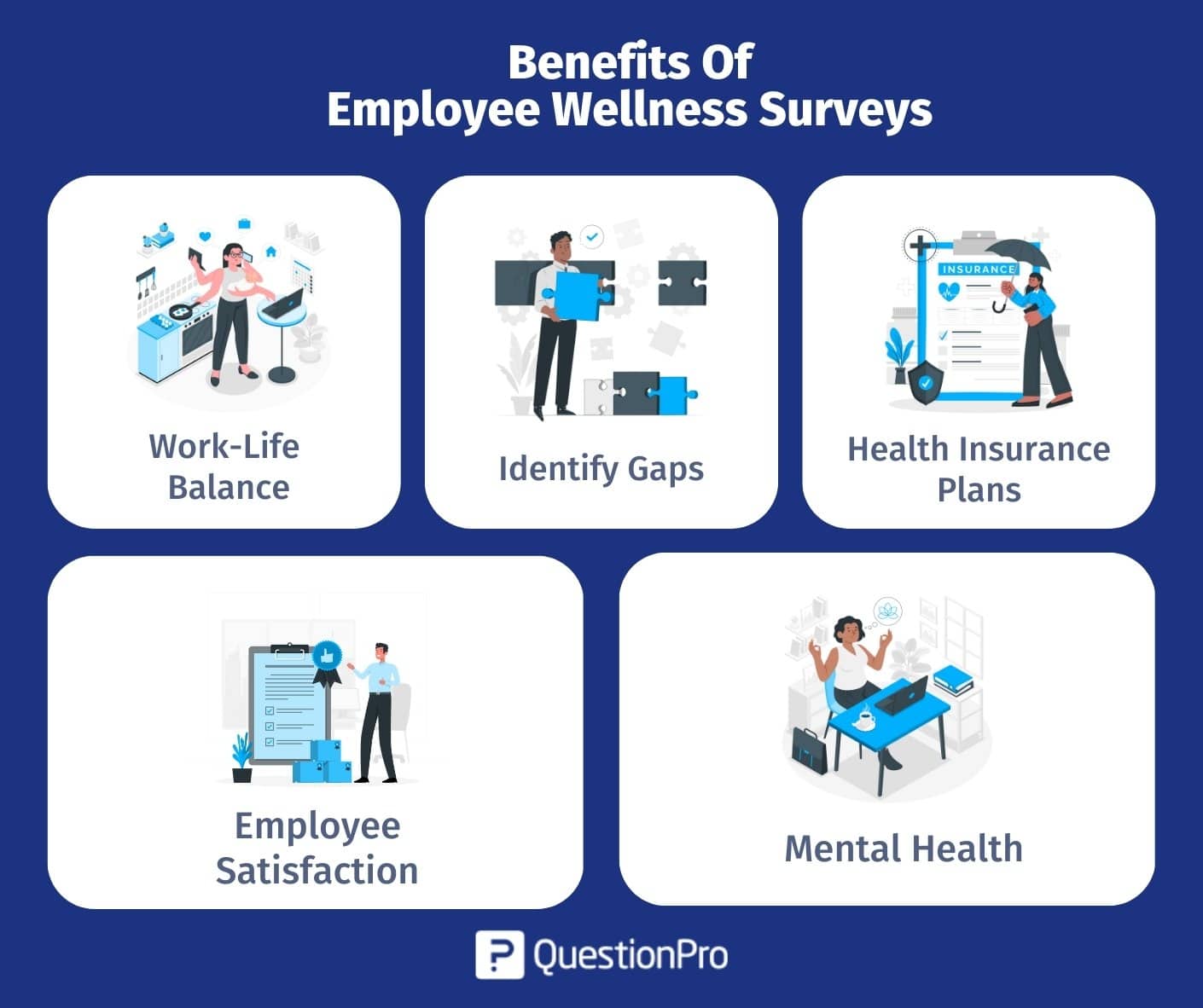
Organizations use an employee wellness survey to assess their workforce’s overall health, which means physical, mental, and emotional health.
The purpose of the survey is to obtain data on employee health care survey and well-being as well as to pinpoint areas that could use improvement to support their general well-being. Employers can create personalized wellness campaigns and programs to meet their employees’ unique needs with the survey’s results.
Employers may foster a healthier and more productive workplace that will promote employee happiness, retention, and business results by putting a priority on employee wellness.
LEARN ABOUT: Survey Mistakes And How to Avoid
So let’s find out more details about the employee wellness survey, its top 20 questions, tips for running a successful survey, and so much more.
What is an employee wellness survey?
An employee wellness survey is a set of questions primarily asked to establish a direct correlation to their happiness, productivity, and retention rate.
It is used to gauge and understand how much importance employees give to their wellness and well-being at the workplace.
Let us share a little secret with you that most people will hesitate to share. If you inspire your employees, they will work harder for you and set your company on the path to success. Pretty simple, right?
LEARN ABOUT: Employee Care
But do you know what the game changer is here? It is the employee wellness survey.
Importance of employee wellness survey
Employee wellness surveys are important for companies to understand their employees’ health and well-being. Here are some of the essential reasons why this kind of survey is crucial:

1. Determine wellness needs
Employee wellness surveys can assist companies in determining their employees’ health and well-being needs. Organizations can better understand the areas where employees may require assistance by asking questions regarding physical health, mental health, stress, and work-life balance.
LEARN ABOUT: Workforce Planning Model
2. Assess the effectiveness of wellness programs
Employee well-being surveys can also be used to assess the effectiveness of wellness initiatives and programs.
Organizations can measure if their wellness programs are achieving their desired results by asking questions regarding employees’ participation in wellness programs and their impressions of the program’s influence on their health and well-being.
3. Boost employee engagement
By conducting wellness surveys, companies demonstrate their commitment to the health and well-being of their employees. Employee engagement and job satisfaction can rise as people feel valued and supported by their employers.
Learn more: employee engagement survey examples
4. Increase retention:
A strong employee wellness program based on the results of an employee wellness survey can assist companies in increasing retention. Employees are more inclined to stay with their employer when they feel supported and healthy.
5. Address any potential problems:
Finally, employee wellness surveys can assist companies in identifying potential issues affecting employee health and wellness.
For example, if many employees report high levels of stress or burnout, the firm can address those concerns and foster a better workplace culture.
LEARN ABOUT: Work culture
Top 20 questions to ask in your employee wellness survey
An employee wellness survey helps you understand the wellness preference of employees in the workplace. Employee well-being is directly proportional to the employee(s) performance at work.
A recent study says that only 12% of organizations globally consider employees’ well-being a priority. This survey can help you understand the employee(s) outlook on well-being.
Free survey template: Employee Wellness Survey Questions + Sample Questionnaire Template
Below are the top 20 employee wellness survey questions you can use in your survey:
Survey questions for employee wellness
1. Considering your overall experience with employee well-being, how likely are you to recommend your friends or family to work with us?
2. Personally, is employee wellness important to you?
3. Do you follow any exercise or employee training routines?
4. List down the fitness activities you indulge yourself in.
5. Do you often snack during your work hours?
6. Have you invested in a good health insurance plan?
7. Please list down all the medical examinations you have had in the last six months.
8. Do you feel stress from work is affecting your personal life?
9. Would you be interested in attending a wellness program at work?
10. What do you think should be the duration of each session?
11. Do you think conducting wellness programs during office hours is helpful?
12. Would it be helpful if the organization provided a healthy snacking option?
13. Please list down if you have any medical conditions.
14. Do you use any tobacco products?
15. Do you consume alcohol?
Survey questions for demographics assessment
16. What is your Gender?
17. Please specify your ethnicity.
18. Please write your date of birth
19. Please specify your relationship status.
20. Is there anything else that you want to add to help us improve employee wellness in our organization?
Learn more: 7 Demographic Survey Questions for Questionnaire
Tips for running a successful employee wellness survey
Suppose you want to start a new corporate workplace wellness program from scratch or improve your current one. In that case, sending a survey to your employees to collect their feedback should be a part of your regular process.
For example, you may have conducted a training program for your employees, a simple way to collect their feedback is to deploy a post-training evaluation survey to get the relevance of the training imparted.
Although employee wellness survey is found everywhere in organizations, they do lack the focus of participation; this only means one thing, they don’t produce the desired result.
LEARN ABOUT: Employee Wellness
Here are the four tips to help you run a successful worksite wellness employee interest survey within your organization:
Tip 1: Ask the right questions, always
The first and most important aspect of the employee well-being survey is asking the correct employee survey questions. This is where most of the survey creators err. Instead of focusing on asking the right questions, most professionals focus more on the aesthetics of the survey. Don’t get me wrong, that is equally important.
Don’t spend too much time making your survey look beautiful or making your questions flowery. Instead, focus solely on the purpose of the information that you would like to procure after deploying the survey. The purpose of your survey should be to gather the following information:
- How are your employees using your current wellness program?
- What is it that your employees expect of the wellness program?
- Do your employees need a new wellness program?
Every question you ask should be able to answer the value of an investment in your various initiatives. The questions you ask could vary from one organization to the other. If you focus your questions on current needs and future requirements, you will be able to get appropriate answers.
Tip 2: Communicate effectively
Once you have added appropriate questions to your employee well-being survey that centers around the attributes mentioned above, you can now shift your focus on effectively communicating about the survey.
Again, this is a common stumbling block for survey creators, as creating proper communication channels for a voluntary survey is difficult.
Once again, there is no “one” solution for how you should communicate effectively will all the members of the team. Here are some interesting tips to get timely results:
- Know the best practices: The marketing team in the organization generally has a creative way of spreading the message. Connect with them and how to understand how you can communicate with the rest of the employees and make them aware of the survey.
- Give time to revert: You must set a time to receive responses for the deployed survey. Setting up a timeline will help people respond in time. At the same time, don’t fall into the trap of wanting the results fast.
- Communicate in a proper channel: Depending on your employees’ demographics and work habits, choose the right channel to communicate with people. It could be over an email, chat apps, or SMS, whatever the population prefers.
Tip 3: Reward your employees
Rewarding your employees for their time in responding to the survey is always a good practice. Of course, you are providing them with a free wellness session, but that may or may not inspire everyone.
LEARN ABOUT: Employee Rewards Ideas for Employee Engagement
Gift your employees with the following:
- Meal coupons
- Gift cards
- Company-based incentives, like free healthy meals for a week for anyone who participates in the survey.
Tip 4: Use data to implement the program
Once you have closed the survey and received the responses, you should have the necessary information you need to roll out the wellness program. This data is important and can be used throughout the year to benchmark it with the previous data.
Consider, for a fact, for an organization, data in any form is gold, and your employees are the goldmine. Ask the right questions to collect the data if you need authentic information.
For example, once you have received the responses to your survey, you will now know precisely how many employees are interested in a wellness program.
From this list, you can again filter and pinpoint the different physical activities employees have chosen. So the following year, when you send them the survey, your questions will be more specifically directed.
Benefits of conducting employee wellness surveys
Now that we understand what types of questions should be included in an employee wellness service let’s look at the employee benefits of conducting workplace wellbeing surveys:

Finding work-life balance
Finding a work-life balance is crucial for all employees. Some of your employees may be parents, some of your employees may be attending some classes, and some may be traveling long distances to come to work.
This survey will help you identify the concerns of these employees and help address them. You can pass on the data collected to managers so they can provide flexibility or help as and when needed.
Identify gaps
Not all organizations run employee wellness programs. It is, however, crucial that all organizations have some sort of wellness program in place, big or small. Workplace well-being surveys will help you identify gaps in your programs and bridge them effectively.
Provide competent health insurance plans
Organizations must provide market-comparable health insurance plans. Conducting worksite wellness surveys will help you identify what employees feel about your insurance plans and what possible additions can be made to them for employees’ benefit.
Improve employee satisfaction
It affects employee satisfaction in a lot of ways. Any health issues or medical conditions may hamper an employee’s performance and satisfaction at work. Conducting surveys can help identify these issues and provide necessary help to all employees concerned.
LEARN ABOUT: Employee Satisfaction Survey Template
Mental health
Such surveys frequently include questions about mental health as a critical component because it is so important to a person’s overall well-being. These surveys seek to understand what causes occupational stress or poor mental health in employees as well as what kind of support they require to get better.
Employee wellness survey dos and don’ts
Dos
1. Keep it short – Don’t pile on questions in your survey. Keep your survey short and to the point to avoid survey fatigue. Keep your survey for less than 10 minutes, and test it before you deploy it.
2. Keep the first question easy – You are not deciding on what you want to buy from a grocery shop! Keep the first question simple. The employee surveys that you find on Google are not tailored enough to extract meaningful information.
3. Allow open-ended responses – Responses to open-ended questions may feel time-consuming, but it’s where you will get the most relevant information. You need to ask the questions these questions toward the end of the survey.
4. Ask questions to understand the perception – You need to ask questions that will help you understand the perception of the employees towards wellness. This information is especially helpful when you want a year-on-year comparison of the collected data.
Don’ts
1. Avoid asking leading questions – As the name suggests leading questions to push respondents to answer in a specific manner wholly based on how they are framed. These questions already contain information. The responses to such questions are biased.
2. Don’t ask vague questions – Asking questions that are not directly related to the topic can lead to an increased rate of survey dropout. You must keep your survey respondents engaged so that you get useful data.
3. Don’t keep every question in the compulsory option – Some survey respondents are uncomfortable answering all the demographic questions. Don’t put your respondents in a spot. If the survey requires them to furnish personal information, then give them a choice.
4. Don’t keep every question mandatory to answer – Always keep a timeline associated with submitting the survey. One week is a good time for respondents to submit their responses. Keeping the survey open for a long time would again lead to a higher survey dropout rate.
If you wish to learn more about the workplace wellness survey, kindly write to us.
How QuestionPro can help in employee wellness surveys?
Employee wellness is essential for company performance and should be a continuous emphasis. Remember to keep it entertaining and regularly interact with staff, whether it’s through pulse checks or annual surveys – you might be surprised at what you find.
This kind of survey can be designed and carried out using QuestionPro, a robust online survey platform. QuestionPro can assist with such surveys in the following ways:
- Templates for customizable surveys: QuestionPro offers a variety of templates for customizable surveys with a focus on employee wellbeing. Using these templates, you may create your survey more quickly and with greater confidence that you are asking the proper questions to gather the required data.
- Simple survey builder: QuestionPro offers a drag-and-drop survey builder that makes it simple to design your own employee wellbeing survey. This implies that you may construct a survey that looks professional without knowing any coding or other technical abilities.
- Various question types: QuestionPro provides a selection of question types, including multiple-choice, rating scales, and open-ended questions. This means you can inquire about various topics to learn more about your staff’s wellness requirements and preferences.
- Real-time data analysis: After your survey is finished, QuestionPro offers real-time data analysis capabilities so you can quickly examine and visualize the results. This makes it simple to spot trends and patterns in your data and make informed judgments regarding your employee health initiative.
- Anonymous responses: QuestionPro allows respondents to submit their answers anonymously in order to promote candid and open feedback. You may receive more accurate and sincere feedback from your staff as a result.
QuestionPro can be useful for generating and administering employee wellness surveys and gathering the information you need to improve your wellness program and promote your employees’ well-being.







